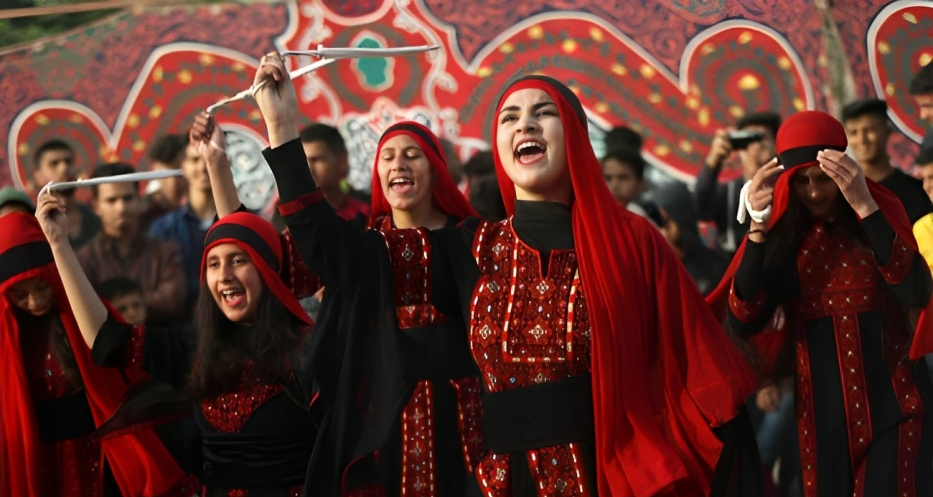
Palestinian girls wearing traditional clothes and cheering for their culture.
Culture Deep Dive: Palestine
For many years, Palestine has been a focal point of major historical events. Despite the ongoing events, the Palestinian people have continued to shine a light on their vibrant culture.
Cuisine:
Palestinian cuisine is a whirlwind of diverse flavors and cultures. Most of the culinary traditions here are a fusion of the cultures from civilizations previously settled. Cooking styles, techniques and dishes are a mixture of Mediterranean, Middle Eastern, Turkish and Levantine influence.
The culinary landscape of ancient Palestine is divided into three primary regions— Galilee, Gaza, and the West Bank. Each region offers unique cuisine based on seasons and heritage.
The Galilee is known for its assortment of spices and herbs. Dishes such as Kibbee and Pilaf are especially popular. Both dishes are subservient to meats blanketed in spices.
In Gaza, cuisine was mainly influenced by neighboring Egypt and the Mediterranean coast. Seafood is a predominant feature in their culinary culture. Sayadiyya and Samak bi Tahini are among the traditional fish dishes of Gaza. These two dishes consist of tender fish served alongside flavourful vegetables and sauces.
The West Bank is a largely cultivated region, with various crops like melons, olives, eggplants and even watermelons. The community’s pride in crops is especially notable in their cuisine. Maqluba, for example, is an eggplant-based casserole with an abundance of vegetables such as carrots and cauliflowers.
In spite of culinary distinction between regions, there is one ingredient in particular that is considered a staple in all Palestinian cooking: olive oil. Olives wield both culinary and spiritual significance to Palestinians. Olive trees are widely considered a symbol of nationality, connection and resistance, mainly due to their longevity. Furthermore, about 80,000 Palestinian families rely on the annual olive harvest for income. This festive harvest sets about the autumn season, typically from October to November wherein olives are ripe and ready for trade.
Musakhan, the national dish of Palestine, is heavily reliant on the olive oil commerce. Musakhan is a roasted chicken sauteed with onions, sumac, saffron and numerous other spices. It is served on a bed of taboon bread and finished off with fried pine nuts. Nonetheless, Palestinians alike suggest that the dish simply would not be the same without olive oil. Musakhan serves as a testament to the harvest season, as it is lovingly prepared to celebrate the success of freshly pressed olive oil. Many of Palestine’s popular dishes could not be made possible without olives.
Traditional Clothing:
Traditional Palestinian clothing is fabricated through tatreez, or Palestinian embroidery. Tatreez represents the identity of Palestine and its people using a variety of colors and patterns to symbolize social and community status. Palestinians use clothing as a method of determining regional identity and family wealth. Hence, designs and colors vary from village to village. Every tatreez piece serves as a scope into the story and history of an individual. Tatreez craft ranges from hats, vests, accessories, pillows, headscarves and throbes (Palestinian dresses).
Palestinian embroidery is a laborious feat. The craft includes a wide array of techniques such as cross-stitching and couching stitching. Even traditional methods like manajal (connecting stitch) and jadleh (hemming stitch), which call for more complexity and dedication. Most embroiderers are females who adopted the skill from their mothers.
Music, Dance, and Poetry:
Dabke is the name for Palestine’s traditional folk dance. While Dabke is native to Levantine regions including Syria and Lebanon, it is an important element of Palestinian culture nonetheless. The dance emphasizes synchronization and plenty of movement such as stomping and clapping. It is a group effort, typically performed in line with a leader. Dancers link hands and move counterclockwise to the beat.
Palestinian music is not known for lyrics; rather, its lively rhythm. Some of the most common instruments used include the oud, a stringed instrument, the mijwiz, a type of clarinet, and the tabla, a type of drum. Depending on the occasion, Palestinian music can either reflect the joys or struggles of daily life.
Poetry is an extremely popular art form for the people of Palestine. Poetry has evolved into a method of political activism. Poets such as Mahmoud Darwish and Tawfiq Zayyad are known for actively speaking on the Palestine experience. Their work, alongside countless other Palestinian poets, are not widely circulated due to conflict with Israeli and Arab governments. Hence, the Palestine Festival of Literature was created in view of their shared struggles. It is an annual festival dedicated to the authors and poets of Palestine.